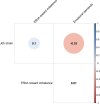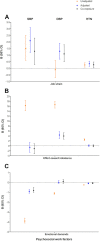Psychosocial work factors and blood pressure among 63 800 employees from The Netherlands in the Lifelines Cohort Study
- PMID: 34215566
- PMCID: PMC8666827
- DOI: 10.1136/jech-2021-216678
Psychosocial work factors and blood pressure among 63 800 employees from The Netherlands in the Lifelines Cohort Study
Abstract
Objectives: Previous studies on the association between psychosocial work factors and blood pressure mainly focused on specific occupations or populations and had limited sample sizes. We, therefore, investigated the associations between psychosocial work factors and blood pressure in a large general working population in the Netherlands.
Methods: We included 63 800 employees from the Netherlands, aged 18-65 years, with blood pressure measurements and a reliable job code at baseline. Psychosocial work factors (job strain, effort-reward imbalance (ERI) and emotional demands) in the current job were estimated with three recently developed psychosocial job exposure matrices. To examine the associations, regression analyses adjusted for covariates (age, sex, body mass index, education, monthly income, pack-years, smoking, alcohol consumption and antihypertensive medication (not included for hypertension)) were performed.
Results: Higher job strain was associated with higher systolic blood pressure (SBP) (B (regression coefficients) (95% CI) 2.14 (1.23 to 3.06)) and diastolic blood pressure (DBP) (B (95% CI) 1.26 (0.65 to 1.86)) and with higher odds of hypertension (OR (95% CI) 1.43 (1.17 to 1.74)). Higher ERI was associated with higher DBP (B (95% CI) 4.37 (3.05 to 5.68)), but not with SBP or hypertension. Higher emotional demands were associated with lower SBP (B (95% CI) -0.90 (-1.14 to -0.66)) and lower odds of hypertension ((OR) (95% CI) 0.91 (0.87 to 0.96)).
Conclusions: In the general working population, employees in jobs with high job strain and ERI have higher blood pressure compared with employees with low job strain and ERI. Emotional demands at work are inversely associated with blood pressure.
Keywords: blood pressure; hypertension; occupational health.
© Author(s) (or their employer(s)) 2022. Re-use permitted under CC BY-NC. No commercial re-use. See rights and permissions. Published by BMJ.
Conflict of interest statement
Competing interests: The corresponding author, HMB, declares (after collecting completed Unified Competing Interest form from all the authors) no support from any organisation for the submitted work, no financial relationships with any organisations that might have an interest in the submitted work in the previous 3 years, and no other relationships or activities that could appear to have influenced the submitted work.
Figures



Similar articles
-
Do dimensions from the Copenhagen Psychosocial Questionnaire predict vitality and mental health over and above the job strain and effort-reward imbalance models?Scand J Public Health. 2010 Feb;38(3 Suppl):59-68. doi: 10.1177/1403494809353436. Scand J Public Health. 2010. PMID: 21172772
-
Psychosocial work environment and ambulatory blood pressure: independent and combined effect of demand-control and effort-reward imbalance models.Occup Environ Med. 2013 Nov;70(11):815-22. doi: 10.1136/oemed-2013-101416. Epub 2013 Aug 28. Occup Environ Med. 2013. PMID: 24143020
-
The interaction effect of effort-reward imbalance and overcommitment on hypertension among Chinese workers: findings from SHISO study.Am J Ind Med. 2013 Dec;56(12):1433-41. doi: 10.1002/ajim.22254. Epub 2013 Sep 13. Am J Ind Med. 2013. PMID: 24038080
-
Information and communication technology demands at work: the association with job strain, effort-reward imbalance and self-rated health in different socio-economic strata.Int Arch Occup Environ Health. 2016 Oct;89(7):1049-58. doi: 10.1007/s00420-016-1140-8. Epub 2016 May 19. Int Arch Occup Environ Health. 2016. PMID: 27193569 Free PMC article.
-
Job strain, effort-reward imbalance and employee well-being: a large-scale cross-sectional study.Soc Sci Med. 2000 May;50(9):1317-27. doi: 10.1016/s0277-9536(99)00388-3. Soc Sci Med. 2000. PMID: 10728851 Review.
Cited by
-
Increased job strain and cardiovascular disease mortality: a prospective cohort study in U.S. workers.Ind Health. 2023 Jul 29;61(4):250-259. doi: 10.2486/indhealth.2021-0233. Epub 2022 Oct 7. Ind Health. 2023. PMID: 35811129 Free PMC article.
-
The association between wet work and hand eczema in the Dutch general population: Application of a job exposure matrix to the lifelines cohort study.Contact Dermatitis. 2025 Jan;92(1):31-40. doi: 10.1111/cod.14687. Epub 2024 Sep 24. Contact Dermatitis. 2025. PMID: 39315670 Free PMC article.
References
-
- GBD . 2017 risk factor Collaborators. global, regional, and national comparative risk assessment of 84 behavioural, environmental and occupational, and metabolic risks or clusters of risks for 195 countries and territories, 1990-2017: a systematic analysis for the global burden of disease study. Lancet 2017;392:1923–94. 10.1016/S0140-6736(18)32225-6 - DOI - PMC - PubMed
-
- Institute of Medicine (US) Committee on Public Health Priorities to Reduce and Control Hypertension . A population-based policy and systems change approach to prevent and control hypertension. Washington DC: National Academies Press (US), 2010. - PubMed
-
- Karasek RA. Job demands, job decision latitude, and mental strain: implications for job redesign. Adm Sci Q 1979;24:285–307. 10.2307/2392498 - DOI
Publication types
MeSH terms
LinkOut - more resources
Full Text Sources
Medical
